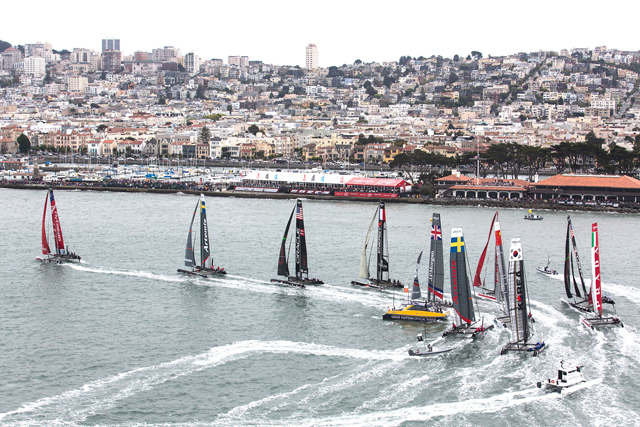A yachting trophy which pre-dates the America's Cup and disappeared from public view for more than 150 years returned to a Dorset regatta and attracted some big-name competitors.
If you were sailing across Poole Bay over the late May bank holiday, you might have wondered what was going on, writes David Harding.
From Boscombe Pier in the east to Studland Bay in the west, fleets of racing yachts, numbering well over 100 in total, were doing battle in the International Paint Poole Regatta.
This biennial event first took place 16 years ago and has grown to become one of the largest regattas in the UK.
This year not only did it make headlines in the press but it also featured on TV, because the overall winner would be presented with the Canford Cup.
This magnificent George IV silver vase was first awarded at the Poole Regatta during one of its earlier incarnations in 1849, meaning it pre-dates the America’s Cup by two years. No one knows exactly what happened to it after that, but it re-appeared at an auction in London last year and has now taken pride of place in Poole Museum having been bought with the help of contributions from the Poole Regatta committee and Poole Yachting Association.
While the profile of the regatta was raised by the attention surrounding the re-discovered trophy, it’s the racing and shore-side socialising that have attracted increasing numbers of entrants. Competitors this year included Mike Golding, sailing one of the new Diam 24s – the super-speedy, launch-from-the-beach trimarans that guarantee white-knuckle sailing and are now used for the Tour de France à la Voile.
They were flying around at 25 knots on the breezier days. Poole Regatta was the inaugural UK gathering for this fast-growing class and the manufacturers even came over to support the event and their first British customers.
Throughout the fleets, you didn’t have to look far to find Olympians, current or former world champions and other sailors who are household names within the sport. Lucy Macgregor was helming Louise Morton’s quarter-tonner, Bullit, which was locked in a regatta-long needle-match with another quarter-tonner, Sam Laidlaw’s Aguila. IRC class 1 went to Premier Flair, owned and sailed by Lucy’s dad and Poole local Jim Macgregor, who has several cabinets full of trophies from other major events. Stuart Jardine, a legend in the J/24 fleet, made a welcome return and showed that, now in his 80s, he’s still on the pace.
Former Fireball world champion Crispin Read-Wilson was competing in the Flying Fifteen class and, inside the harbour, Megan Pascoe recorded a string of bullets in her 2.4mR after missing the first day.
The furthest-travelled entrant was Dizzy, Paul Anstey & Craig Rastello’s classic C&C yawl from the 1960s, which could often be seen giving newer and sportier boats a run for their money. Paul – son of Russell Anstey, who founded Trapper Yachts in the 1960s – sailed over from Florida last year and left the boat in the UK to compete in the regatta.
This was an event that attracted competitors from far and wide and in which local club sailors, who made up the bulk of the fleets, could race against those at the top of the sport. Conditions were superb, starting light on Saturday and progressively building to distinctly fresh on Monday.
And the Canford Cup? This was won by Sam Laidlaw and his team on Aguila, who counted six firsts and a second in their scoreline. Many keen sailors will be looking to emulate their success at the next International Paint Poole Regatta in 2018.
Were you there?
A full gallery of photos from the event can be found at: www.sailingscenes.photodeck.com
How to reef – expert advice from PBO Sail Clinic
How do you ensure an efficient reef with a roller-reefing headsail and slab-reefing mainsail? David Harding explains
How to sail off a mooring
In many situations, leaving the mooring under power is the only sensible option. But if conditions allow, why not spare…
What difference do new sails make?
New sails are a big investment – but are they worth it? The PBO team compared the old with the…
Bermudan rig vs Junk rig
David Harding sets up a direct comparison between Junk- and Bermudan-rigged Splinters to find out how they handle
PBO Sail Clinic: why won’t my boat tack properly?
PBO Technical Editor David Harding offers ideas to help a Kelt 5.50 that won't beat upwind
Poole Regatta provides something for everyone
See our Poole Regatta gallery
Keelboat racing for a worthy cause
Championship event will boost the coffers of Dame Ellen's charity
America’s Cup World Series 2016
America’s Cup World Series (ACWS) Portsmouth, 21-24 July, www.lvacwsportsmouth.com
On water spectator plans revealed for America’s Cup World Series Portsmouth
How to watch the America's Cup World Series Portsmouth racing in the Solent, from 23 to 26 July 2015














